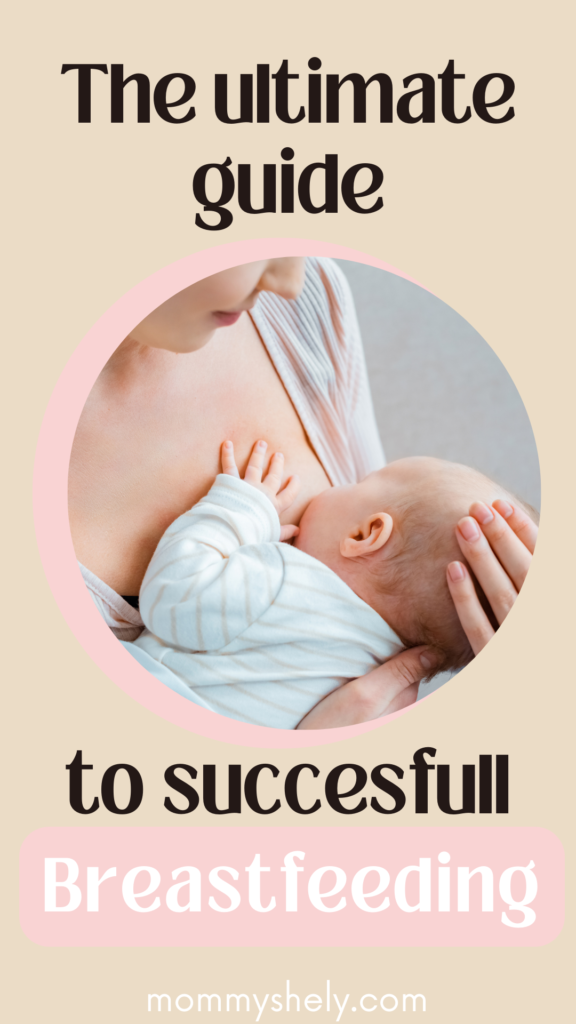Unlike your newborn, who instinctively knows what to do the moment they’re born, learning how to breastfeed might feel a bit harder for you.
Whether you’re a first-time mom or just need a refresher, this guide is here to support you. From latching techniques and comfortable breastfeeding positions to creating a newborn feeding schedule and overcoming common challenges — you’ll find everything you need to breastfeed with confidence and ease.
Pin For Later!

As an Amazon Associate I earn from qualifying purchases. This post may contain affiliate links.
Table of Contents
Breastfeeding Basics for First Time Moms
The Stages of Breast Milk
Breast milk goes through different stages as your baby grows. Nature created each type of breast milk specifically for your baby’s age, making it the ideal food for your little one.
Colostrum
Colostrum is the first milk produced by your body after giving birth. It often referred to as “liquid gold”. Colostrum has essential nutrients and antibodies to provide your newborn with everything they need for a healthy start in life.

The first hour after giving birth, AKA the golden hour, is the perfect time to start breastfeeding. Read why it is so important in here.
In case immediate breastfeeding isn’t possible due to cesarean section, illness, or complications during birth, you can extract colostrum to a collector and provide this golden liquid when possible.
Transitional Milk
The creamy milk that follows colostrum is called transitional milk. Transitional milk is produced two to five days after your baby is born and keeps going until about ten to fourteen days after birth.
In this stage your breasts will become larger and firmer, and you might experience engorgement and leaking. Don’t worry, it’s a normal part of this stage, and the solution is simply to continue feeding your baby.
Mature Milk
Mature milk is thinner and more watery than transitional milk. Adjusting to your baby’s needs with the perfect balance of fats, proteins, and sugars.
Your breasts might feel softer and a bit smaller than they did when you were making transitional milk, but they’ll still be bigger than they were before you got pregnant.
Achieving a Good Latch
A good latch is SO important for successful breastfeeding.
Steps to a good latch:
- Position your baby close to your body with their nose aligned with your nipple.
- Gently touch your baby’s lip with your nipple to encourage them to open their mouth wide.
- Ensure your baby’s mouth covers both the nipple and a significant portion of the areola.
Watch this video to learn how to latch a baby using the exaggerated latch technique:
Pay attention to signs of effective breastfeeding, such as rhythmic sucking and swallowing sounds, to confirm a proper latch.
How Long to Breastfeed
Breastfeeding sessions can take about 20 to 30 minutes. Your baby might need more or less time, especially in the beginning and during growth spurts.
Make sure to fully drain one breast. It’s essential for at least one breast to be well-drained at each feeding. The hind milk, which is the last bit of mature milk, is richer in fats and calories. So, wait until your baby seems ready to finish on the first breast before offering the second one. Don’t force it.
Watch for signs that your baby is done. Look for signs such as relaxed hands and body, decreased sucking frequency, and turning away from the breast.
End the feeding when your baby lets go of the nipple or when the suck-swallow pattern slows down to about four sucks per swallow.
Your baby might fall asleep after the first breast and either wake up to nurse from the second or sleep until the next feeding.
To unlatch, gently press on your breast near your baby’s mouth or insert a clean finger into the corner of your baby’s mouth.
Signs That Your Baby is Hungry
For succesful breastfeeding, feed your baby when you recognize hunger cues. Don’t wait for tears; by then, your baby might be very hungry and uncomfortable.
Your baby will let you know they’re hungry by:
- Nuzzling against your breasts.
- Sucking intensely on their hand, or any of your closest body part.
- Opening their mouth.
- Rooting, which is when they turn their head to the side with their mouth open, looking for the nipple.
- Sucking on their lip or tongue.
- Making lip-smacking sounds.
How Often to Breastfeed
Feeding on demand is the best way for breastfeeding success. That is, feeding your baby when they’re hungry.
Lo and behold, you learned that just now! But… babies usually aren’t born hungry. Their appetite picks up around the third day. So, you might have to “force” the feeding at first.
A newborn needs at least eight to 12 feedings every 24 hours, even if they don’t demand it yet!
That means you’ll probably be nursing every two to three hours. Day and night.
It sounds daunting, I know, but once you get the hang of it (which can take some time), it will become easier. As your milk supply increases and your baby grows, the breaks between feedings will get longer.
Don’t be surprised if your formula-feeding friends say their newborns eat less often. Breast milk is easier to digest, so nursing babies empty their tummies faster and want more food sooner.
Breastfeeding Positions
Try different breastfeeding positions can help you find what works best for you and your baby.
Common breastfeeding positions offer a range of benefits, each catering to different needs and circumstances:
The cradle hold

This is perhaps the most traditional and widely used position. It involves holding your baby in your arms, nestled close to your body.
While this position is comfortable and convenient for many mothers, it’s important to note that it may exert pressure on the abdomen, particularly for mothers who did a cesarean birth.
The cross-cradle hold

This position involves holding your baby across your body, supporting their head with the hand opposite to the breast you’re breastfeeding from.
The cross-cradle hold position often provides better control and support for newborns who may struggle with latching.
The football hold

In this position the baby is tucked under your arm like a football, so it can be advantageous for breastfeeding twins or babies with reflux issues. However, it may require extra support for your arm and the baby’s head to ensure proper alignment and comfort.
Side-lying position

My favorite position! Where both you and your baby lie on your sides facing each other.
This position can be particularly beneficial for nighttime feedings, allowing you both to relax while nursing.
Breastfeeding Essentials
Burp Cloths
Burp cloths are a MUST HAVE for breastfeeding moms. They help to catch spit-up and protect your cloths during feeding and burping.
Keep a supply of soft, absorbent burp cloths on hand to use during and after feedings. Especially if your baby is prone to spitting up or reflux.
Milk Collecting Cup
A milk collecting cup, such as the Haakaa, is a game-changer! Use it to collect and save extra breast milk effortlessly.
Simply attach the Haakaa to your opposite breast while nursing to catch let-down milk, which would otherwise be wasted.
Nursing Pads
Nursing pads, also known as breast pads or bra pads, absorb leaks and prevent embarrassing stains on clothing.
Available in disposable and reusable options, nursing pads are designed to fit discreetly inside your bra and provide comfortable protection throughout the day.
Keep a supply of nursing pads on hand, especially during the early weeks of breastfeeding when leaks are most common.
Nipple Cream
Nipple cream is a must-have item for breastfeeding mothers experiencing soreness, dryness, or cracking of the nipples.
Look for a lanolin-based nipple cream, which is safe for both mom and baby and provides soothing relief for tender nipples.
Apply nipple cream after each feeding or as needed to moisturize and protect your nipples from further irritation.
Breastfeeding Pillow
A breastfeeding pillow, also known as a nursing pillow, is a supportive cushion designed to make breastfeeding more comfortable for both mom and baby. Reducing strain on your arms, shoulders, and neck during feeding sessions.
Choose a breastfeeding pillow with adjustable straps or a wrap-around design for a secure fit, and opt for a machine-washable cover for easy cleaning.
A breastfeeding pillow can be a lifesaver, especially during nighttime feedings or long nursing sessions!
Nursing Bra
Selecting the right nursing bra is essential for a comfortable and successful breastfeeding and pumping experience.
When choosing a nursing bra, prioritize comfort, support, and accessibility for breastfeeding. Look for bras with adjustable straps, soft fabric, and easy-to-open cups to facilitate nursing sessions.
Consider investing in multiple bras to accommodate changes in breast size and ensure a proper fit throughout your breastfeeding journey.
A pro tip: you can convert a nursing bra into a pumping bra! Simply use a hair tie or rubber band to secure the clasps of your nursing bra in the open position, allowing easy access for your breast pump flanges.
Breastfeeding-friendly Clothing
Breastfeeding-friendly clothing is essential for convenient and discreet nursing on the go.
Look for tops, dresses, and sleepwear with features such as hidden panels, wrap designs, or button-down fronts for easy access to the breast.
Choose soft, stretchy fabrics that allow for comfortable movement and accommodate changes in breast size.

Common Breastfeeding Challenges
Breastfeeding should not be painful! If you experience pain during or after breastfeeding, you need to address it.
A few common causes of breastfeeding and nipple pain include:
Engorgement
Engorgement is the overfilling of breasts with milk. It can cause discomfort and difficulty latching for both you and your baby.
To relieve engorgement, apply warm compresses or take a warm shower to encourage milk flow and gently massage your breasts to express milk.
Nursing frequently and ensuring good latching can help with engorgement. Using a breast pump to express milk between feedings can provide some relief.
Nipple Pain
Nipple pain is a common breastfeeding challenge. It can be caused by improper latch, friction, or sensitivity.
Apply lanolin cream or coconut oil to soothe and moisturize sore nipples, and allow them to air dry after feedings. If that doesn’t do the trick, consider using nipple shields to protect your nipples while nursing.
Mastitis
Mastitis is a painful inflammation of the breast tissue often accompanied by fever, chills, and flu-like symptoms.
To treat mastitis, rest and stay hydrated. Be sure to continue breastfeeding to empty the breast fully. Apply warm compresses and massage the affected area to promote milk flow.
If symptoms persist or worsen, consult with a healthcare provider, as mastitis may require antibiotics to resolve.
Low Milk Supply
Low milk supply (or perceived low milk supply) can be a real source of stress and concern.
To support milk production, you need to ensure frequent and effective breastfeeding or pumping. Stay hydrated, eat a balanced diet, and get plenty of rest (easier said than done, I know).
Oversupply
Oversupply of breast milk can lead to engorgement, fast flow, and difficulty latching.
To manage oversupply, nurse on one breast per feeding to allow your baby to fully drain the breast and regulate milk supply.
Use breast compression techniques during feedings to control flow and prevent choking or gagging. Or try nursing in a reclined position to slow down the flow of milk and allow your baby to control the feed.
Consider pumping for comfort or to relieve engorgement if necessary, but avoid overstimulating the breasts, as this can exacerbate oversupply.
Blocked Milk Ducts
Blocked milk ducts occur when milk ducts become clogged, leading to tender lumps or knots in the breast.
To clear blocked ducts, apply warm compresses or take warm showers to encourage milk flow and massage the affected area towards the nipple.
Experiment with different breastfeeding positions to promote drainage. Use a breast pump or hand expression to relieve pressure if needed.
If none of it seems to work, seek guidance from a lactation consultant or healthcare provider for further assistance.
Nutrition and Support while Breastfeeding
Eating Right While Breastfeeding

Maintaining a balanced diet is crucial for supporting your milk supply.
Focus on eating a variety of nutrient-rich foods, including fruits, vegetables, lean proteins, whole grains, and healthy fats. Stay hydrated by drinking plenty of water throughout the day (keep a water bottle on hand at all times).
Snacking while breastfeeding can help maintain energy levels and support milk production. Choose healthy snacks like nuts, yogurt, or whole-grain crackers to keep you feeling satisfied between meals.
Listen to your body’s hunger and thirst cues, and nourish yourself with wholesome, nourishing foods to ensure optimal health and well-being for you and your baby.
Supplements and Home Remedies
In addition to a healthy diet, some moms may benefit from supplements to support lactation and boost milk supply.
Fenugreek, blessed thistle, and Brewer’s Yeast are commonly used herbal supplements believed to enhance milk production.
it’s essential to consult with a healthcare provider before starting any supplements, as they may interact with medications or have side effects.
In addition to supplements, certain foods and beverages, such as oatmeal, fennel tea, and lactation cookies, are believed to increase milk supply.
Breastfeeding and Pumping
Breastfeeding goes hand in hand with pumping, especially for moms who need flexibility or are returning to work.
While direct breastfeeding creates a unique bond between you and your baby, pumping as its own perks. It allows moms to maintain their milk supply and continue providing breast milk even when they are apart.
This combination helps moms manage their busy lives while still giving their babies the best nutrition.
Read More: How to Combine Breastfeeding and Pumping Like a Pro
Breastfeeding is a beautiful thing, but it definitely has its challenges. You need to know that it’s normal to face hurdles. Just remember that you’re not alone! There’s support out there to help you tackle any challenges you may face.
Remember to be patient with yourself and your baby, and celebrate the special bond you’ve built with your baby. You’ve got this, mama!
Did you find this guide helpful? If you have any breastfeeding tips or experiences to share, drop a comment below!
With love,
Shely




This is such helpful information in your guide to breastfeeding. All new mothers have so many questions and they can find the answers here. Thanks for sharing!
Thanks Julie! Glad you liked it 🙂
Thank you for sharing this comprehensive guide!!